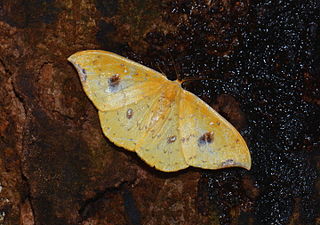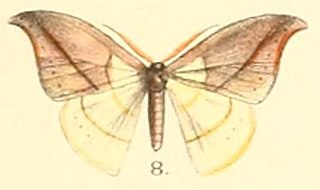
Drepaninae are by far the largest subfamily of the Drepanidae moths. While it is usually split into two tribes, Drepanini and Oretini, its internal systematics and phylogeny are not well resolved.
Tridrepana bicuspidata is a moth in the family Drepanidae. It was first described by Song, Xue and Han in 2011. It is found in Hainan, China.
Tridrepana crocea is a moth in the family Drepanidae. It was described by John Henry Leech in 1889. It is found in China, Japan and Korea.
Tridrepana finita is a moth in the family Drepanidae. It was described by Watson in 1957. It is found in China.
Tridrepana fulva is a moth in the family Drepanidae. It was described by George Hampson in 1893. It is found in Tibet in China, Sikkim in India and Nepal.

Tridrepana fulvata is a moth in the family Drepanidae. It was described by Snellen in 1876. It is found in China, India, Myanmar, Malaysia and Indonesia.
Tridrepana marginata is a moth in the family Drepanidae. It was described by Watson in 1957. It is found in Yunnan, China.

Tridrepana postica is a moth in the family Drepanidae. It was described by Frederic Moore in 1879. It is found in north-eastern India and Malaysia.

Tridrepana subtusmaculata is a moth in the family Drepanidae. It was described by Max Gaede in 1933. It is found on Peninsular Malaysia and Borneo.
Tridrepana sadana is a moth in the family Drepanidae. It was described by Frederic Moore in 1865. It is found in China, India, Nepal and Myanmar.
Tridrepana adelpha is a moth in the family Drepanidae. It was described by Swinhoe in 1905. It is found in north-eastern India.
Tridrepana melliflua is a moth in the family Drepanidae. It was described by Warren in 1922. It is found in New Guinea, but probably also occurs in Papua New Guinea.
Tridrepana sigma is a moth in the family Drepanidae. It was described by Allan Watson in 1957. It is found in Indonesia.
Tridrepana spatulata is a moth in the family Drepanidae. It was described by Allan Watson in 1957. It is found on Luzon and Mindanao in the Philippines.
Tridrepana mediata is a moth in the family Drepanidae. It was described by Warren in 1922. It is found in New Guinea, extending to Goodenough Island and Sudest Island in the south-west.
Tridrepana obscura is a moth in the family Drepanidae. It was described by Allan Watson in 1957. It is found in Indonesia.
Tridrepana septempunctata is a moth in the family Drepanidae. It was described by Warren in 1896. It is found in Assam in India and on Sumatra in Indonesia.
Tridrepana olivacea is a moth in the family Drepanidae. It was described by Warren in 1922. It is found in New Guinea, extending to Goodenough Island and the Bismarck Archipelago.
Tridrepana obliquitaenia is a moth in the family Drepanidae. It was described by Warren in 1922. It is widely distributed in New Guinea.
Tridrepana rectifascia is a moth in the family Drepanidae. It was described by Allan Watson in 1957. It is found on Mindanao in the Philippines.



